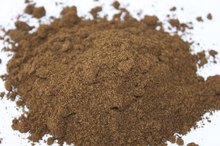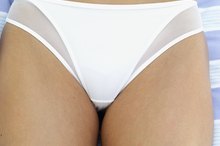Natural Male Enlargement Exercises
Every man would like to be thought of as a virile animal, but for those with a small penis it can be embarrassing to take off your clothes. There are exercises that can naturally increase both the length and girth of your penis, but they must be performed properly in order to be effective.
If you are experiencing serious medical symptoms, seek emergency treatment immediately.
Jelqing
The website MaleEnhancement.org reports that this technique is an effective natural enhancement exercise 2. It is performed while your penis is almost completely erect, since this exercise can cause injury if performed on a fully erect member. Apply plenty of lubrication to your penis and use your thumb and forefinger to form the “okay” sign at the base of your penis. Slightly squeeze your penis at the base and then pull your thumb and forefinger down the length of your shaft. Stop when you reach the head of your penis and repeat with your other hand. The website notes that each individual stroke should take several seconds, and recommends beginners start with 100 strokes. Over time, increase this to 500 strokes.
- The website MaleEnhancement.org reports that this technique is an effective natural enhancement exercise 2.
- Apply plenty of lubrication to your penis and use your thumb and forefinger to form the “okay” sign at the base of your penis.
Stretching
Arabic Jelqing Exercises
Learn More
This technique is recommended as an effective method to increase the length of your penis by the website 4 Men’s Health 1. It is performed while your penis is not erect, and should be repeated between 10 and 15 times to be effective. Grab your flaccid penis around the head and pull it slightly forward until your penis is stretched to its maximum comfortable limit. Hold this stretch for about 15 seconds before releasing the stretch. The website Free Penis Enlargement Guide suggests shaking your penis vigorously after the stretch to help relax the muscles 1. You can also stretch your penis to the right and left during this exercise, according to the penis enlargement website 1.
Ballooning
This exercise uses the urge to ejaculate during stimulation to help increase penis size, according to MaleEnhancement.org. It is performed by holding back your ejaculate by holding your palm firmly over the head of your penis as you feel you are about to ejaculate. Repeated use of this technique can cause the stretching of tissues inside your penis that will result in increased size, according to the website.
Related Articles
References
- 4Men's Health: Penis Enlargement
- Male Enhancement.org: Exercises
- Marra G, Drury A, Tran L, Veale D, Muir GH. Systematic review of surgical and nonsurgical interventions in normal men complaining of small penis size. Sex Med Rev. 2019;2019:S2050-0521(19)30012-5. doi:10.1016/j.sxmr.2019.01.004
- Hatipoğlu N, Kurtoğlu S. Micropenis: etiology, diagnosis and treatment approaches. J Clin Res Pediatr Endocrinol. 2013;5(4):217-23. doi:10.4274/Jcrpe.1135
- Karavalos S, Stewart J, Evbuomwan, McEleny K, Aird I. Assessment of the infertile male. TOG. 2013 Jan;15(1):1-9. doi:10.1111/j.1744-4667.2012.00145.x
- Kim SO, Ryu KH, Hwang IS, Jung SI, Oh KJ, Park K. Penile growth in response to human chorionic gonadotropin (HCG) treatment in patients with idiopathic hypogonadotrophic hypogonadism. Chonnam Med J. 2011;47(1):39-42. doi:10.4068/cmj.2011.47.1.39
- Van der Horst HJ, De Wall LL. Hypospadias, all there is to know. Eur J Pediatr. 2017;176(4):435-41. doi:10.1007/s00431-017-2864-5
- Egydio PH, Kuehhas FE, Sansalone S. Penile length and girth restoration in severe Peyronie's disease using circular and longitudinal grafting. BJU Int. 2013;111(4 Pt B):E213-9. doi:10.1111/j.1464-410X.2012.11582.x
- Kwon YS, Farber N, Yu JW, et al. Longitudinal recovery patterns of penile length and the underexplored benefit of long-term phosphodiesterase-5 inhibitor use after radical prostatectomy. BMC Urol. 2018;18(1):37. doi:10.1186/s12894-018-0341-8
- King IC, Tahir A, Ramanathan C, Siddiqui H. Buried penis: evaluation of outcomes in children and adults, modification of a unified treatment algorithm, and review of the literature. ISRN Urol. 2013;2013:109349. doi:10.1155/2013/109349
- Prause N, Park J, Leung S, Miller G. Women's preferences for penis size: a new research method using selection among 3D models. PLoS ONE. 2015;10(9):e0133079. doi:10.1371/journal.pone.0133079
- Veale D, Miles S, Read J, et al. Penile dysmorphic disorder: development of a screening scale. Arch Sex Behav. 2015;44(8):2311-21. doi:10.1007/s10508-015-0484-6
- Oderda M, Gontero P. Non-invasive methods of penile lengthening: fact or fiction?. BJU Int. 2011;107(8):1278-82. doi:10.1111/j.1464-410X.2010.09647.x
- Oates J, Sharp G. Nonsurgical medical penile girth augmentation: Experience-based recommendations. Aesthet Surg J. 2017;37(9):1032-8. doi:10.1093/asj/sjx068
- Bescós R, Sureda A, Tur JA, Pons A. The effect of nitric-oxide-related supplements on human performance. Sports Med. 2012;42(2):99-117. doi:10.2165/11596860-000000000-00000
- Usta MF, Ipekci T. Penile traction therapy for Peyronie's disease - what's the evidence?. Transl Androl Urol. 2016;5(3):303-9. doi:10.21037/tau.2016.03.25
- Ahmed U, Freeman A, Kirkham A, Ralph DJ, Minhas S, Muneer A. Self injection of foreign materials into the penis. Ann R Coll Surg Engl. 2017;99(2):e78-e82. doi:10.1308/rcsann.2016.0346
- Campbell J, Gillis J. A review of penile elongation surgery. Transl Androl Urol. 2017;6(1):69-78. doi:10.21037/tau.2016.11.19
- Xu L, Zhao M, Chen W, et al. Augmentation phalloplasty with autologous dermal fat graft in the treatment of small penis. Ann Plast Surg. 2016 Feb;77(Suppl 1):S60-5. doi:10.1097/SAP.0000000000000782
- Srinivas BV, Vasan SS, Mohammed S. Penile lengthening procedure with V-Y advancement flap and an interposing silicone sheath: a novel methodology. Indian J Urol. 2012;28(3):340-2. doi:10.4103/0970-1591.102722
- Anandan L, Mohammed A. Surgical management of buried penis in adults. Cent European J Urol. 2018;71(3):346-52. doi:10.5173/ceju.2018.1676
- Egydio PH, Kuehhas FE. Penile lengthening and widening without grafting according to a modified 'sliding' technique. BJU Int. 2015;116(6):965-72. doi:10.1111/bju.13065
- Loreto C, Garaffa G, Dijnovic R, Barbagli G, Villa M, Sansalone S. Penile disassembly: anatomical surgical steps. BJU Int. 2013;112(7):1035-45. doi:10.1111/bju.12413
- Rodriguez KM, Kohn TP, Davis AB, Hakky TS. Penile implants: a look into the future. Transl Androl Urol. 2017;6(Suppl 5):S860-S866. doi:10.21037/tau.2017.05.28
- Chauhan NS, Sharma V, Dixit VK, Thakur M. A review on plants used for improvement of sexual performance and virility. Biomed Res Int. 2014;2014:868062. doi:10.1155/2014/868062
Writer Bio
Keith Strange spent more than a decade as a staff writer for newspapers in the southeastern United States, winning numerous awards for his work. He has a B.S. in wellness/sports medicine from Averett University and completed graduate work in exercise physiology. Strange is a former competitive martial artist and holds a third-degree black belt in tae kwon do.









